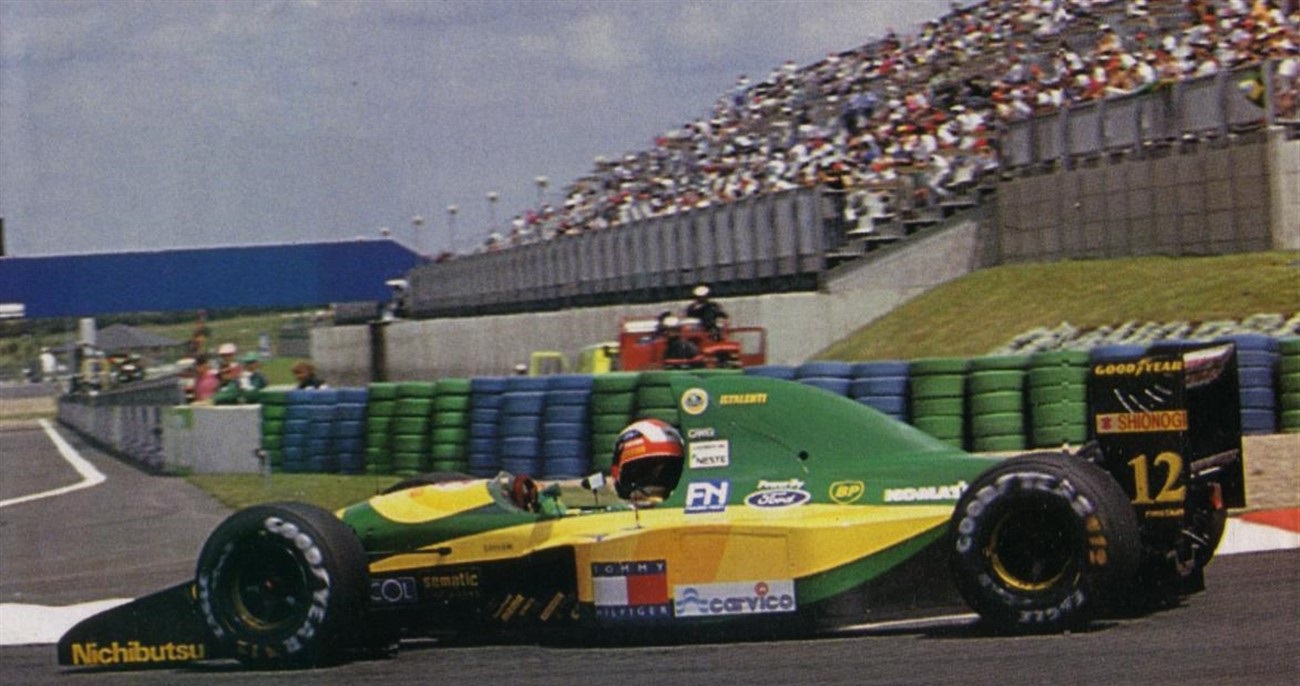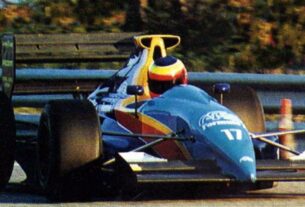Leyton House Racing appeared on the grid in 1990, it was of course the March F1 Team that re-appeared on the grid in 1987. Sponsored by Leyton House a Japanese real-estate company. Where 1990 eventually was a good season, 1991 began badly. Financial struggle, and eventually the arrest of Akira Akagi in September was the begin of the end for the team. However, it did not mean that the team was working on their new car the CG921! Which eventually would become the Lotus 107.
Let’s open up the history of the team a bit more. When Leyton House came as sponsor March was far from March as it once was. In 1987 the team appeared with the turquoise colour scheme. The team showed some decent results and with a young designer Adrian Newey on board the team was doing well. For 1990 the team appeared with the new March CG901, in the begin the car was not good as there were issues with the wind tunnel they used. The result was that Newey was kicked out of the team. Though, not before he made changes to the CG901 which helped the team to become competitive. The 7 points they scored in 1990 could have been much more.
For 1991 Leyton House came with the March CG911. The car was designed by Gustav Brunner and Chris Murphy. Sadly the car was not that reliable as the CG901. Eventually Capelli scored one point during the Hungarian Grand Prix. After the Hungarian Grand Prix everything would change for the team as their team manager and owner of Leyton House, Akari Akagi was arrested in September 1991. Due to the Fuji Bank Scandal.
While the team was during the season already struggling with their financial situation, Akari Akagi was already lowering the funds in the team. Having Leyton House leaving as sponsor the team needed to have to keep the funds coming. Therefore, Capelli was replaced by the Austrian Karl Wendlinger for the last two races. Eventually Akagi sold the team to Ken Marrable, one of his British associates.
While the team was in serious problems it did not mean that the team did not look at the future. In fact Chris Murphy was already working in their successor for 1992 the March CG921. The design for the CG921, what I could uncover, started in June/July 1991, a few months before Akagi was arrested. The CG921 was penned and it seems that an mock-up version of the car was already build.
According to a retweet on one of my twitter post Andy Brown posted that they used the Leyton House wind tunnel to conduct their own wind tunnel testing for the Galmer team. In a corner, under a cover, there was a car, which had similar shapes to the Lotus 107. Was this the March CG921? Sadly there was no sneak peak to know this.
There are reports in several magazines that state that the design was completed and that the car would be ready in November/December 1991. Ready to be tested on the track. I tried to contact Chris Murphy but sadly i had no reply so far regarding the March CG921.
As already mentioned, after Akagi got arrested due to the fraud, the Leyton House scene went into a financial crisis. It meant that the team would go back to the March F1 Team name. As well, Chris Murphy was lurked to Team Lotus. Also Team Lotus had a financial problem. The team was still racing with the updated Lotus 102, which was already a few years old. Lurking Murphy away from March meant that they would have a new car for 1992!
Yes indeed the blueprint for the Leyton House CG921 came with Chris Murphy to Team Lotus. As Murphy completed the design and the team started working no building the car it would take a few months before it was completed, and finetuned. Johnny Herbert was the first driver to be able to drive with the Lotus 107. This happened during the Grand Prix on San Marino. The first points for the Lotus 107, which was powered by the Ford HB V8, came during the French Grand Prix.
Eventually the team managed to score 13 points during the twelve races that were left during the season. Compared with todays Formula One score system the team would have scored 62 points! Just to show you how good the car was. In 1993 the team came with the Lotus 107B, which was still a competitive car with 12 points.
Looking at the results for the Lotus 107, could the March CG921 be the secure deal for the March team to survive in the Formula One? March appeared with the CG911B on the grid in 1992. The car was still a successor with scoring 3 points due a fourth place during the Canadian Grand Prix. With todays system the team would have scored 18 points.
Having the CG21 appeared on the grid fitted with the Ilmor V10 engine it could have been the car the team needed to survive in the Formula One. However, we all know that you won’t survive in the Formula One without someone who has unlimited funds or the needed sponsors that are willing to invest in your team. Looking at the economical situation in the early 90s it could still be that March would not have survived it.




